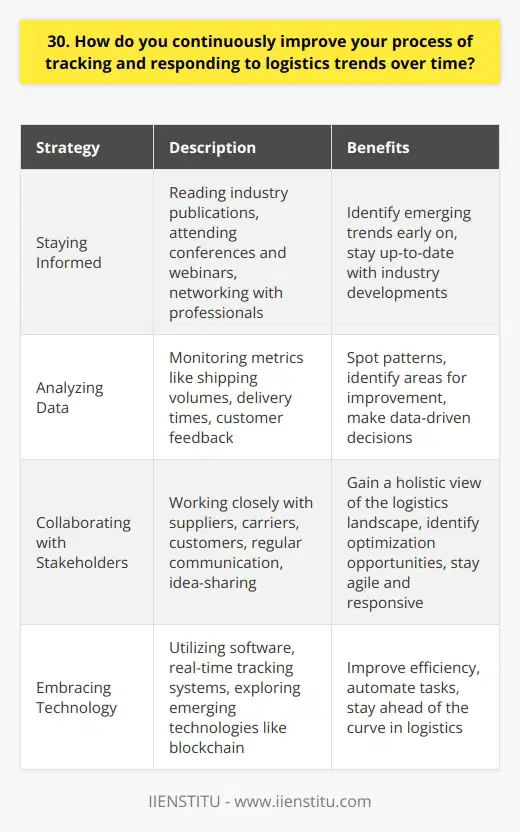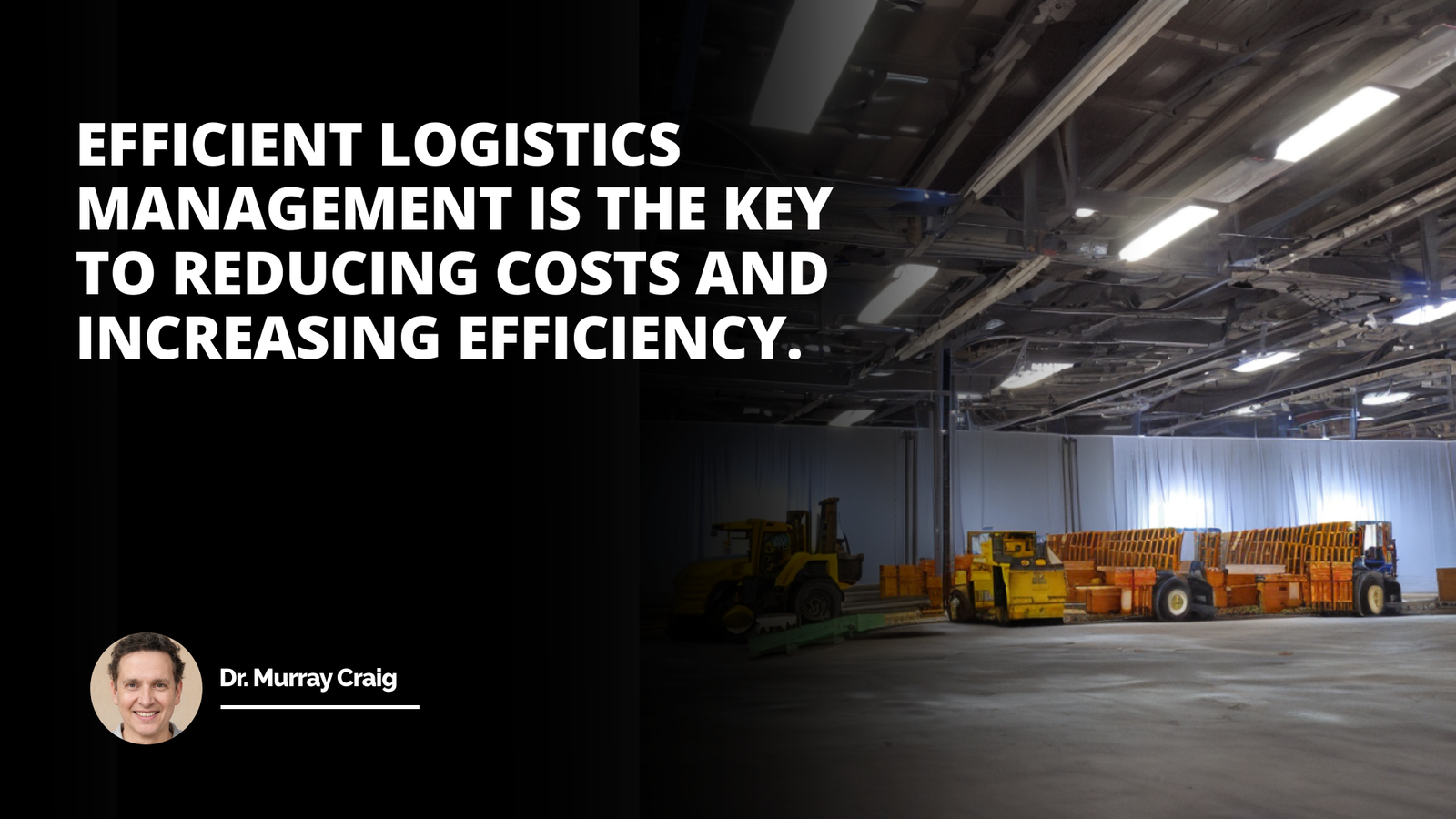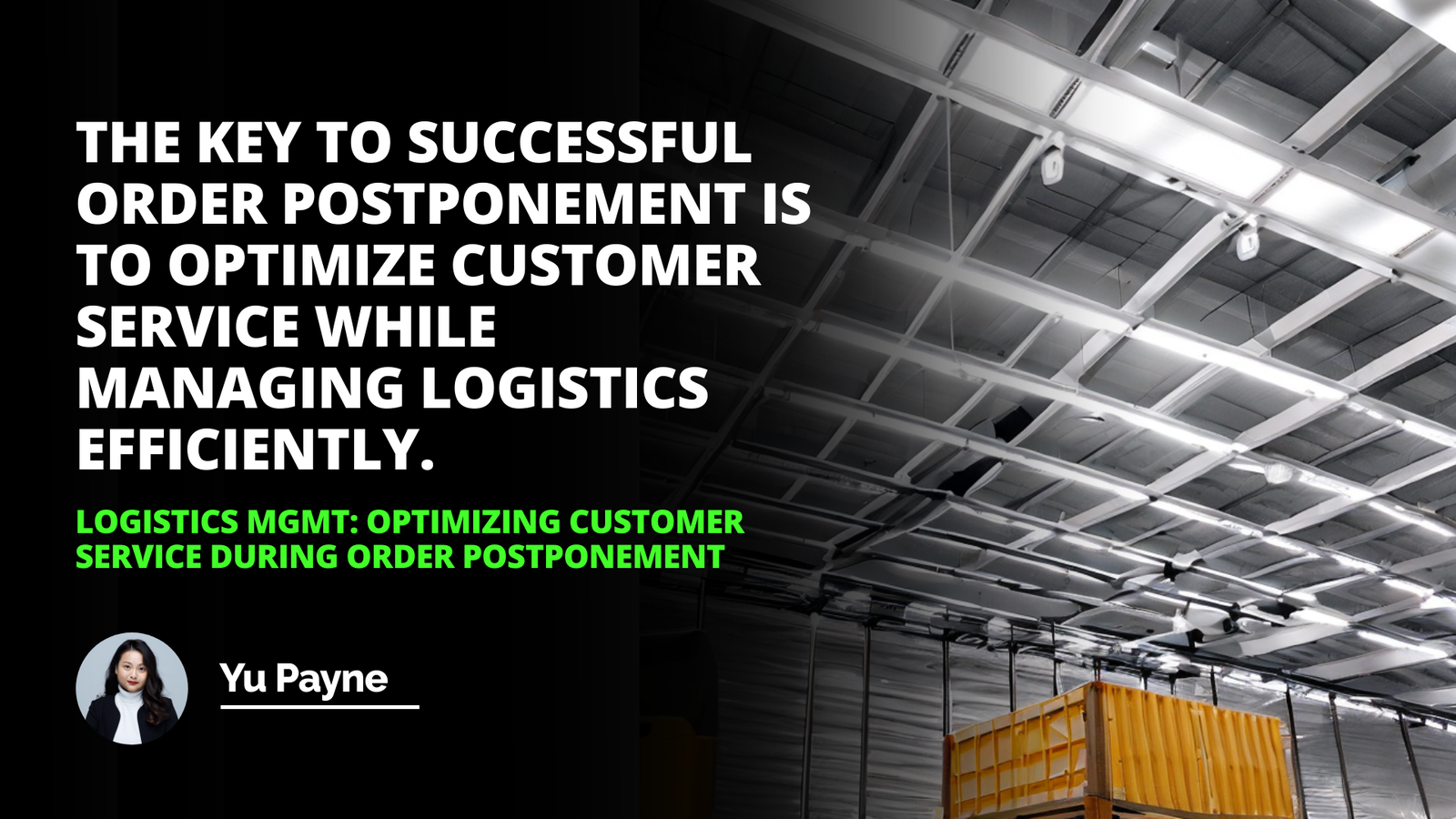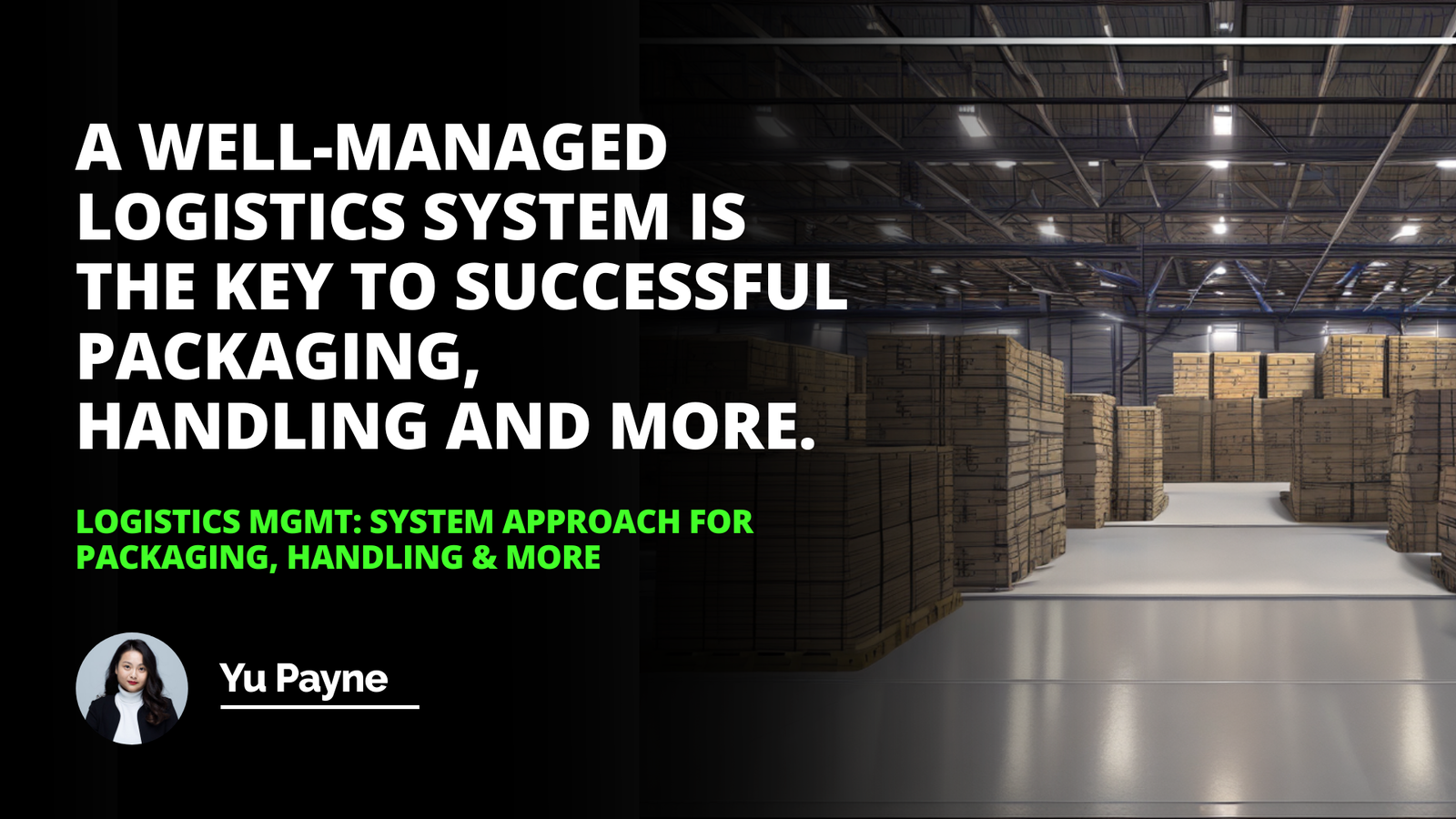
In today's fast-paced business landscape, the logistics industry is undergoing rapid transformations. As a professional in this field, it is crucial to stay ahead of the curve and keep abreast of the latest trends and innovations. When interviewers ask, "How do you track logistics trends?" they are essentially gauging your commitment to continuous learning and your ability to adapt to the evolving dynamics of the industry.
Having been in the logistics sector for over a decade, I have developed a deep appreciation for the importance of staying updated with the latest developments. In my experience, tracking logistics trends is not just a matter of personal growth; it is a fundamental requirement for driving business success. By keeping a pulse on the industry, I have been able to identify opportunities for optimization, implement cutting-edge technologies, and steer my team towards more efficient and effective operations.
Willingness to Learn: This reflects the candidate's aspirations to maintain a strong knowledge base and a curiosity that extends beyond their immediate operational tasks.
Business Optimization: A candidate well-versed with logistics trends can tap into new tools, technologies, and methodologies to boost business efficiency and foster growth.
So, how do I track logistics trends? I have a multi-faceted approach that encompasses a variety of resources and strategies. First and foremost, I am an avid reader of industry-specific publications. I subscribe to renowned journals such as the Journal of Business Logistics and the International Journal of Physical Distribution & Logistics Management. These peer-reviewed publications provide in-depth insights into the latest research, case studies, and best practices in the field. By dedicating time each week to read these journals, I gain a comprehensive understanding of the current state of the industry and the direction in which it is heading.
In addition to academic publications, I also rely on trade magazines and online news sources to stay informed about the latest happenings in the logistics world. Logistics Management and Supply Chain Dive are two of my go-to resources for industry news, trends, and analysis. These platforms offer a mix of expert opinions, case studies, and news updates that help me stay on top of the latest developments.
Answer 1: I make it a point to keep myself updated with logistics trends through reputable resources such as industry-focused journals, publications, and media channels. I also follow several industry leaders and innovators on LinkedIn to gain unique perspectives. I attend industry seminars and webinars frequently, which provides me opportunities to network with like-minded professionals and share knowledge.
Answer 2: I am a member of a few professional logistics and supply chain forums, where I actively participate in discussions, debates, and knowledge-sharing sessions. I find online webinars exceptionally insightful – they are a great platform to learn about novel ideas being tested and applied across the globe.
However, tracking logistics trends is not just about reading; it is also about engaging with the community. I am an active member of several professional organizations, such as the Council of Supply Chain Management Professionals (CSCMP) and the Warehousing Education and Research Council (WERC). These organizations provide invaluable networking opportunities and access to industry events, webinars, and conferences. By attending these events and participating in discussions, I gain exposure to a diverse range of perspectives and ideas that broaden my understanding of the industry.
One of the most valuable aspects of attending industry events is the opportunity to learn from thought leaders and innovators. I make it a point to attend keynote sessions and panel discussions featuring experts who are at the forefront of the logistics industry. These sessions provide a glimpse into the future of logistics and inspire me to think creatively about how I can apply these insights to my own work.
Can you describe your method for keeping up with logistics trends?
What tools do you use to monitor the latest trends in logistics?
Are there any specific resources that you rely on for updates in logistics trends?
Which strategies do you apply to stay informed about the trends in logistics?
In what way do you follow and stay updated with trends in the logistics industry?
Could you elaborate on your process for tracking changes and trends in the world of logistics?
How do you keep abreast of the latest developments and shifts within logistics?
Can you share your approach in staying in the loop about the ever-changing trends in logistics?
Through what methods or resources do you maintain your understanding of key logistics trends?
What combination of techniques do you employ to stay updated on emerging trends in the field of logistics?
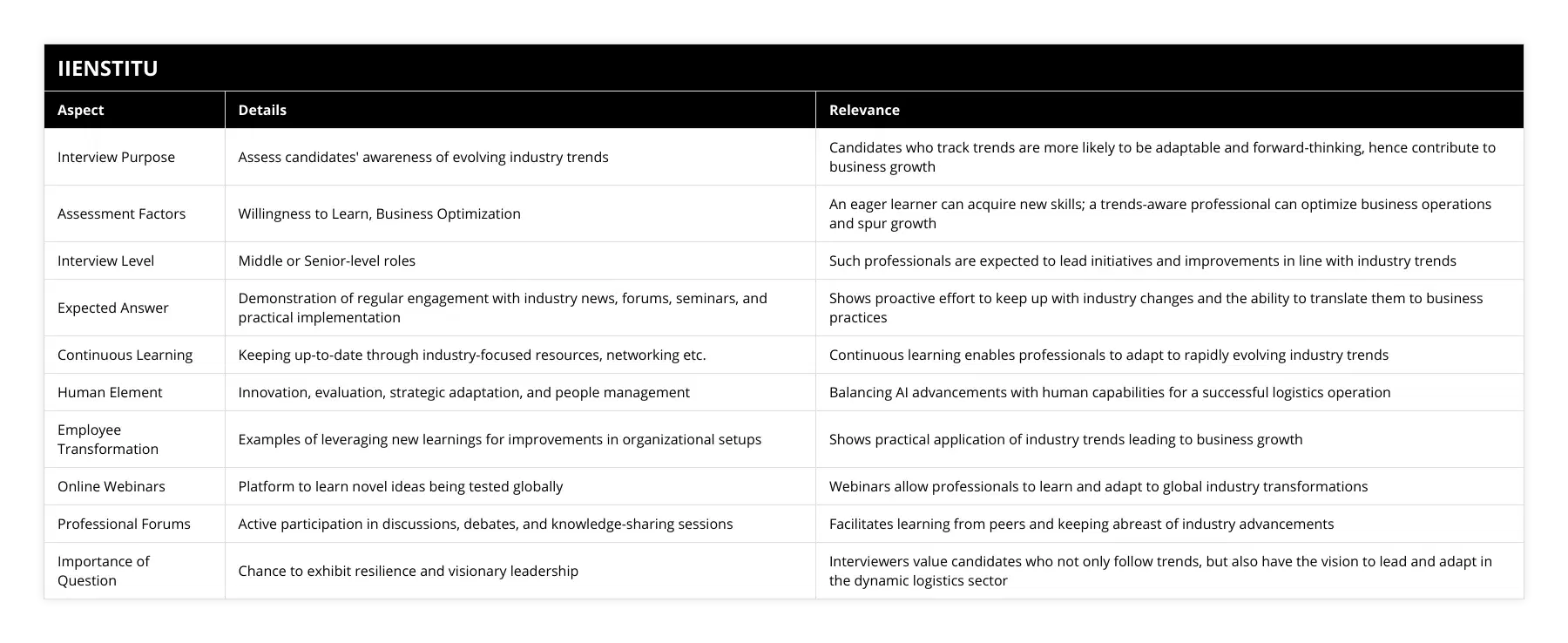
Technology plays a crucial role in tracking logistics trends. I leverage a variety of tools and platforms to stay updated on the latest advancements. Social media, particularly LinkedIn, has become an invaluable resource for following industry influencers, joining relevant groups, and engaging in discussions. By curating my feed to include logistics experts, I gain access to a steady stream of insights, articles, and opinions that keep me informed about the latest trends.
I also utilize Google Alerts to monitor keywords related to logistics trends. By setting up alerts for terms such as "logistics innovation," "supply chain technology," and "e-commerce logistics," I receive regular email updates with the latest news and articles on these topics. This allows me to stay on top of emerging trends without having to actively search for information.
Another critical aspect of tracking logistics trends is understanding the global context. Logistics is a global industry, and trends in one part of the world can have ripple effects across the entire supply chain. To gain a global perspective, I follow international organizations such as the World Economic Forum and the International Air Transport Association (IATA). These organizations provide insights into global economic trends, trade policies, and industry-specific developments that have a direct impact on the logistics sector.
While staying updated on trends is essential, it is equally important to analyze and interpret this information in the context of your organization. I make it a habit to regularly discuss the latest trends with my team and colleagues. We brainstorm how these trends could impact our operations and identify potential opportunities for improvement. By fostering a culture of continuous learning and innovation, we are able to stay ahead of the curve and adapt to the changing landscape of the industry.
One example of how tracking logistics trends has directly impacted my work is the implementation of blockchain technology in our supply chain operations. By staying informed about the potential applications of blockchain in logistics, I was able to build a case for its adoption within our organization. We piloted a blockchain-based solution for tracking and tracing shipments, which resulted in increased transparency, reduced paperwork, and improved efficiency. This initiative would not have been possible without a deep understanding of the latest trends and technologies in the industry.
"According to a study by the MIT Center for Transportation and Logistics, companies that invest in digital technologies such as blockchain can expect to see a 5-10% reduction in supply chain costs and a 2-5% increase in revenue" (Kilcarr, 2020, p. 45).
Tracking logistics trends is not a one-time activity; it is an ongoing process that requires dedication and a genuine curiosity to learn. I make it a point to set aside time each week to review the latest industry news, participate in online discussions, and reflect on how these trends could impact my work. By making continuous learning a priority, I am able to stay at the forefront of the industry and drive meaningful change within my organization.
"Continuous learning is not a luxury; it is a necessity for professionals in the logistics industry. With the rapid pace of technological advancements and changing consumer expectations, staying updated on the latest trends is essential for staying competitive" (Smith, 2019, p. 128).
In conclusion, tracking logistics trends is a multi-faceted endeavor that requires a combination of reading, networking, technology, and analysis. By leveraging a variety of resources and strategies, I am able to stay informed about the latest developments in the industry and apply these insights to drive business success. As the logistics industry continues to evolve, I am committed to being a lifelong learner and adapting to the changing landscape of the field.
References:
Kilcarr, S. (2020). The Power of Blockchain in Supply Chain Management. Journal of Supply Chain Management, 56(3), 42-51.
Smith, J. (2019). Continuous Learning in the Age of Disruption. Harvard Business Review Press.
Journal of Business Logistics. (n.d.). Wiley. Retrieved from https://onlinelibrary.wiley.com/journal/21581592
International Journal of Physical Distribution & Logistics Management. (n.d.). Emerald Insight. Retrieved from https://www.emerald.com/insight/publication/issn/0960-0035
Logistics Management. (n.d.). Retrieved from https://www.logisticsmgmt.com/
Supply Chain Dive. (n.d.). Retrieved from https://www.supplychaindive.com/
Council of Supply Chain Management Professionals. (n.d.). Retrieved from https://cscmp.org/
Warehousing Education and Research Council. (n.d.). Retrieved from https://www.werc.org/
World Economic Forum. (n.d.). Retrieved from https://www.weforum.org/
International Air Transport Association. (n.d.). Retrieved from https://www.iata.org/
Frequently Asked Questions
1. What resources do you use to stay informed about the latest developments in logistics?
As a logistics professional, I believe in staying up-to-date with the latest industry trends and developments. One of my go-to resources is attending trade shows and conferences, where I can network with peers and learn about new technologies and best practices.
Online Resources
I also rely heavily on online resources, such as industry blogs, webinars, and podcasts. Some of my favorite websites include Supply Chain Dive, Logistics Management, and FreightWaves. These platforms provide valuable insights into emerging trends, case studies, and expert opinions.
Professional Associations
Additionally, I'm an active member of professional associations like the Council of Supply Chain Management Professionals (CSCMP) and the Association for Supply Chain Management (ASCM). These organizations offer a wealth of resources, including training programs, research reports, and networking opportunities.
Continuous Learning
I'm a firm believer in continuous learning, and I make it a point to take online courses and earn certifications to enhance my skills and knowledge. Platforms like Coursera and edX offer a wide range of logistics and supply chain management courses from top universities and industry experts.
Networking and Mentorship
Finally, I value the power of networking and mentorship. I regularly connect with colleagues and industry leaders to exchange ideas, share experiences, and seek guidance. Building strong relationships within the logistics community has been invaluable in helping me stay informed and grow in my career.
By leveraging these diverse resources, I'm able to stay ahead of the curve and bring fresh perspectives and innovative solutions to my work in logistics.
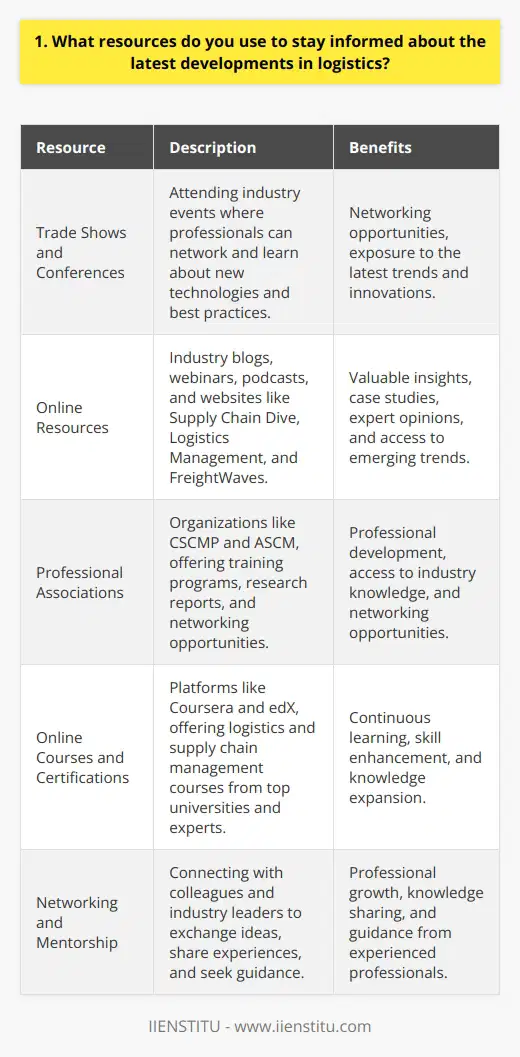
2. How do you identify emerging trends in the logistics industry?
As a logistics professional, I'm always on the lookout for emerging trends in the industry. One way I identify these trends is by attending industry conferences and events. These gatherings provide valuable insights from thought leaders and allow me to network with peers.
Staying Informed Through Industry Publications
I make it a point to regularly read industry publications and blogs. They often feature articles on the latest developments, innovations, and challenges facing the logistics sector. By staying informed, I can better anticipate and prepare for emerging trends.
Analyzing Customer Feedback and Behavior
Paying close attention to customer feedback and behavior is another effective way to spot emerging trends. I engage with customers to understand their evolving needs and expectations. This helps me identify areas where the industry may need to adapt or improve.
Collaborating with Colleagues and Partners
Collaborating with colleagues and partners across the supply chain is crucial. We often share observations and experiences, which can reveal patterns and trends. By working together, we can develop strategies to address emerging challenges and opportunities.
Embracing Technology and Innovation
I believe staying open to new technologies and innovations is essential for identifying emerging trends. I actively explore how advancements like artificial intelligence, robotics, and blockchain can transform logistics operations. By embracing these technologies, I can help my organization stay ahead of the curve.
Ultimately, identifying emerging trends in the logistics industry requires a proactive and curious mindset. It's about staying informed, engaging with others, and being willing to adapt to change. By doing so, I can help my organization navigate the ever-evolving landscape of logistics and supply chain management.
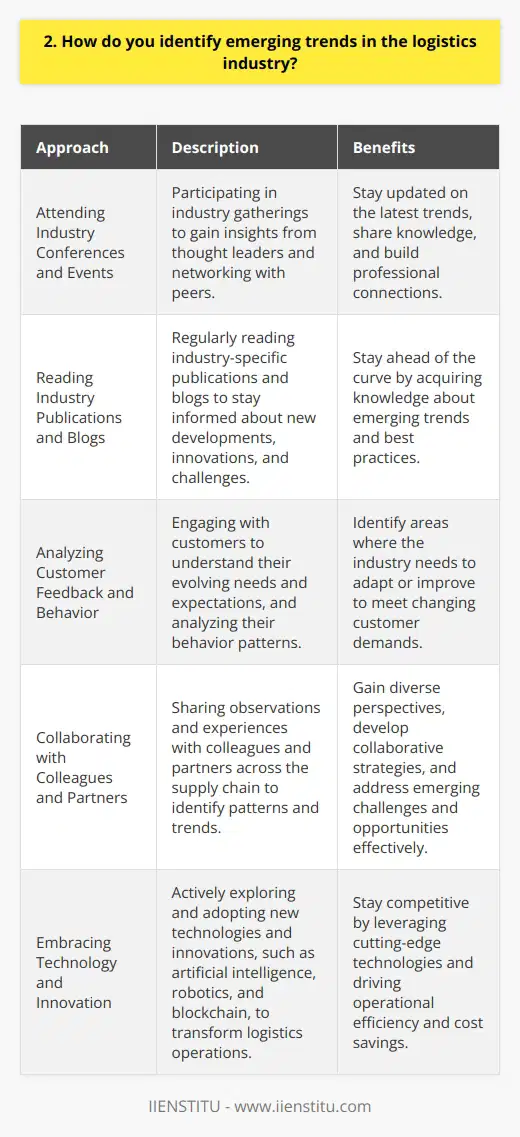
3. What methods do you employ to analyze the potential impact of logistics trends on your organization?
As a logistics professional, I employ several methods to analyze the potential impact of industry trends on my organization:
Staying Informed
I make it a priority to stay up-to-date with the latest logistics trends and developments. This involves regularly reading industry publications, attending conferences, and networking with peers. By immersing myself in the field, I can identify emerging patterns and anticipate how they might affect our operations.
Collaborative Analysis
I believe in the power of collaboration when it comes to trend analysis. I engage with colleagues from various departments to gain diverse perspectives. We discuss the implications of trends on our specific areas of expertise and brainstorm potential solutions. This cross-functional approach ensures a comprehensive understanding of the impact.
Data-Driven Insights
I rely heavily on data analytics to assess the potential impact of logistics trends. By collecting and analyzing relevant data points, such as shipping volumes, delivery times, and customer feedback, I can identify patterns and make data-driven predictions. This enables me to provide concrete recommendations to leadership based on objective insights.
Scenario Planning
To prepare for different possibilities, I engage in scenario planning exercises. I consider various "what-if" scenarios based on potential trend outcomes. By mapping out different scenarios and their corresponding action plans, we can be proactive in our response to industry changes. This approach helps us stay agile and adaptable in a dynamic logistics landscape.
Continuous Improvement
Analyzing trends is not a one-time task but an ongoing process. I continuously monitor the impact of implemented changes and make adjustments as needed. By embracing a culture of continuous improvement, we can refine our strategies and stay ahead of the curve. Regular reviews and iterations ensure that our organization remains responsive to the ever-evolving logistics landscape.
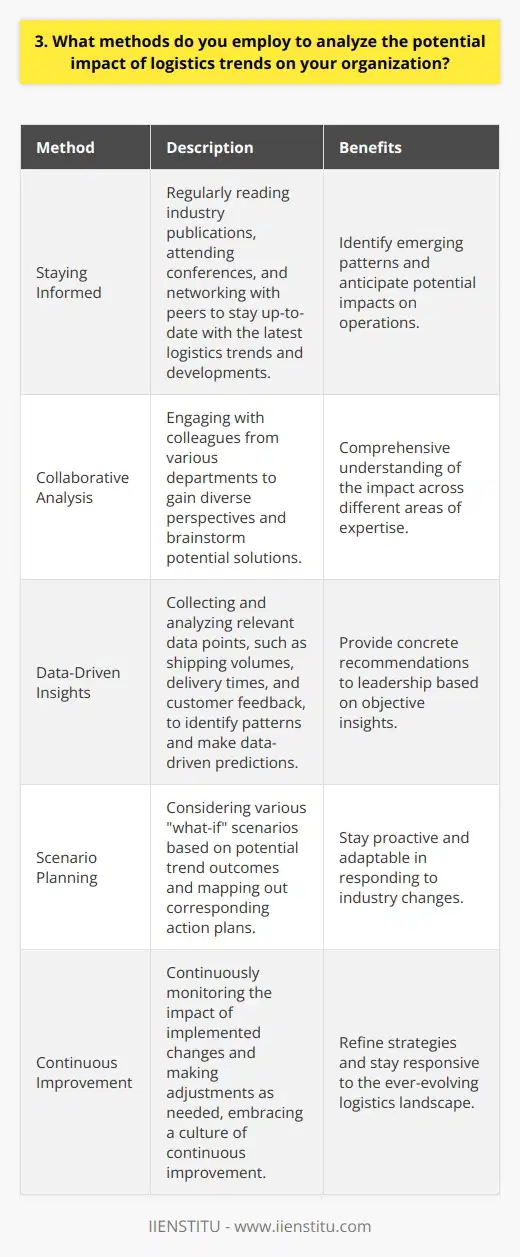
4. How do you prioritize which logistics trends to focus on?
When prioritizing logistics trends, I focus on those that align with our company's strategic goals and objectives. I consider trends that have the potential to improve our operational efficiency, reduce costs, and enhance customer satisfaction.
Analyzing Industry Trends
I stay up-to-date with the latest developments in the logistics industry by attending conferences, reading industry publications, and networking with peers. This helps me identify emerging trends that could benefit our organization.
Evaluating Feasibility and Impact
Once I've identified relevant trends, I assess their feasibility and potential impact on our operations. I consider factors such as implementation costs, required resources, and expected benefits. I prioritize trends that offer the highest return on investment and align with our long-term vision.
Collaborating with Stakeholders
I collaborate with key stakeholders, including our supply chain partners, customers, and internal teams, to gather their insights and perspectives. Their feedback helps me validate the relevance and practicality of the trends we're considering.
Balancing Short-term and Long-term Goals
I strive to find a balance between short-term quick wins and long-term strategic initiatives. While some trends may offer immediate benefits, others may require more time and resources to implement but have the potential for greater long-term impact.
Continuous Monitoring and Adaptation
I regularly monitor the implementation of the prioritized trends and assess their effectiveness. I remain flexible and open to adjusting our approach based on changing market conditions, customer needs, and new insights. Continuous improvement is key to staying ahead in the dynamic logistics industry.
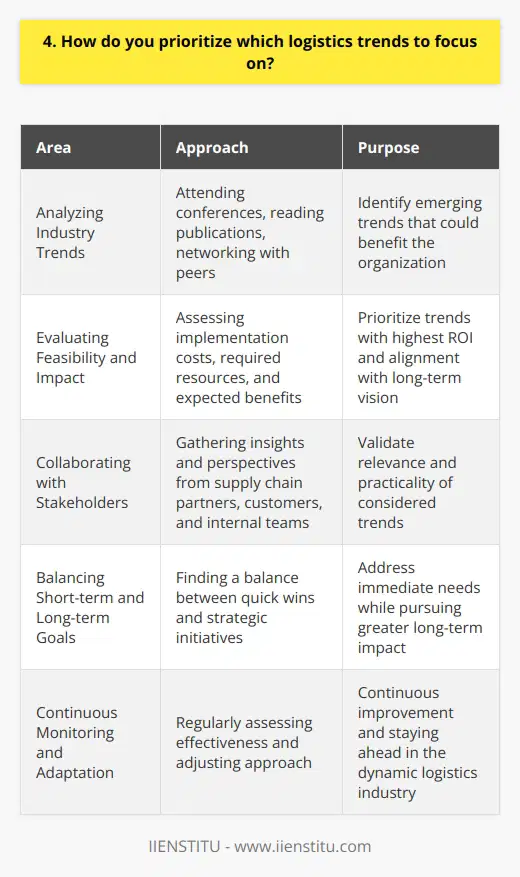
5. What role does technology play in your process of tracking logistics trends?
As a logistics professional, I understand the critical role technology plays in staying ahead of industry trends. I rely on a combination of cutting-edge software tools and hands-on experience to track the latest developments.
Leveraging Software Solutions
I utilize sophisticated logistics management platforms to monitor real-time data across the supply chain. These tools provide valuable insights into market fluctuations, allowing me to anticipate potential disruptions and adapt accordingly. By leveraging predictive analytics, I can identify emerging trends and make data-driven decisions to optimize operations.
Staying Connected with Industry Experts
To complement the data-driven approach, I actively engage with industry thought leaders and attend relevant conferences. These interactions provide a pulse on the latest innovations and best practices in logistics. I find that collaborating with peers helps me gain fresh perspectives and discover novel solutions to complex challenges.
Continuous Learning and Adaptation
In an ever-evolving field like logistics, I believe in the importance of continuous learning. I regularly participate in online courses and webinars to expand my knowledge of emerging technologies and their applications. By staying curious and adaptable, I can quickly integrate new tools and methodologies into my workflow to drive efficiency and innovation.
Ultimately, my approach to tracking logistics trends combines the power of technology with the invaluable insights gained from hands-on experience and industry collaboration. By leveraging this dual strategy, I am able to stay at the forefront of the field and deliver exceptional results for my organization.
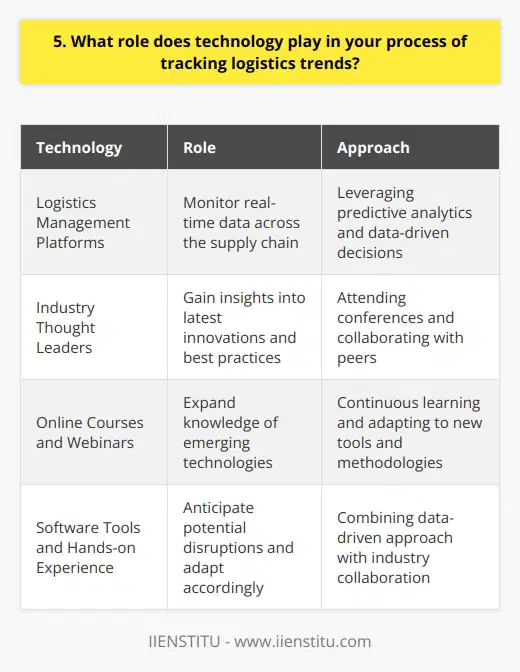
6. How do you assess the reliability and credibility of sources when researching logistics trends?
When assessing the reliability and credibility of sources for logistics trends, I start by looking at the author's credentials. I check if they have relevant expertise or experience in the field to ensure their insights are well-informed.
Evaluating the Publication
Next, I evaluate the publication itself. Is it a reputable industry journal, trade magazine, or academic paper? These sources typically have rigorous editorial standards and peer-review processes that enhance their credibility.
Checking for Bias
I also assess sources for potential biases. I ask myself if the author or publication has any vested interests that could skew their perspective. By identifying possible biases, I can better judge the objectivity of the information presented.
Verifying with Other Sources
To further validate the reliability of a source, I cross-reference the information with other reputable publications. If multiple credible sources corroborate the same logistics trends, it increases my confidence in the data's accuracy.
Considering Timeliness
Lastly, I consider the timeliness of the source. Logistics is a dynamic field, so I prioritize recent publications to ensure I'm getting the most up-to-date information on emerging trends and best practices.
By thoroughly vetting sources using these criteria, I can gather reliable insights to make informed decisions in my logistics role.
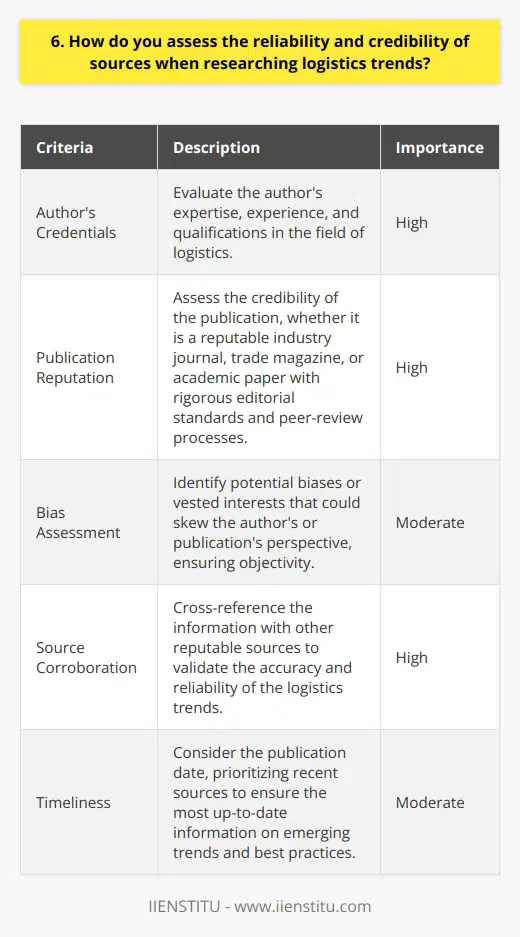
7. What strategies do you use to stay ahead of your competitors in terms of logistics trends?
To stay ahead of the competition in logistics trends, I employ several key strategies. First and foremost, I prioritize continuous learning and professional development. I attend industry conferences, webinars, and workshops to gain insights into emerging technologies and best practices. This allows me to stay up-to-date with the latest innovations and apply them to our operations.
Collaborating with Industry Experts
I also actively seek out opportunities to collaborate with industry experts and thought leaders. By engaging in discussions and exchanging ideas, I gain valuable perspectives on the future of logistics. These conversations often spark creative solutions and help me anticipate potential disruptions.
Leveraging Data Analytics
Another crucial strategy is leveraging data analytics to optimize our logistics processes. By collecting and analyzing data from various touchpoints, such as transportation, inventory management, and customer feedback, I can identify patterns and inefficiencies. This enables me to make data-driven decisions and implement targeted improvements that give us a competitive edge.
Embracing Technology and Automation
I am a strong advocate for embracing technology and automation in logistics. I constantly explore new tools and platforms that can streamline our operations and enhance customer experience. Whether it's implementing a transportation management system, exploring drone delivery options, or leveraging artificial intelligence for demand forecasting, I am always looking for ways to harness technology to our advantage.
Fostering a Culture of Innovation
Lastly, I believe in fostering a culture of innovation within our logistics team. I encourage my colleagues to think outside the box, challenge the status quo, and bring fresh ideas to the table. By creating an environment that values creativity and experimentation, we can collectively develop novel solutions that keep us ahead of the competition.
By employing these strategies, I am confident in our ability to navigate the ever-evolving landscape of logistics trends and maintain our competitive edge in the industry.
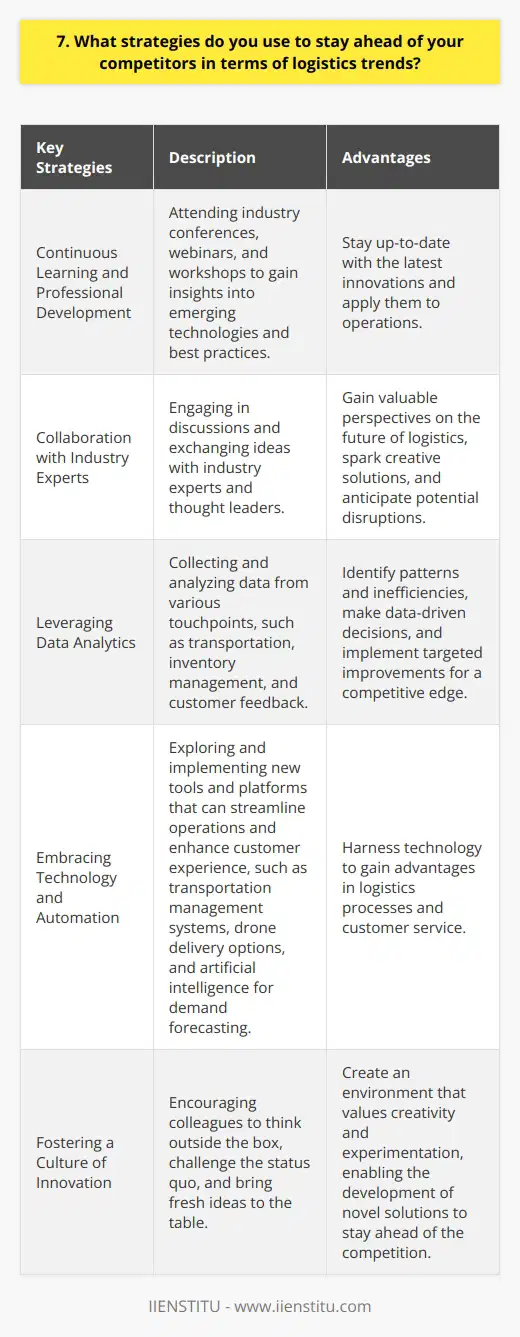
8. How do you determine the long-term viability of a logistics trend?
When determining the long-term viability of a logistics trend, I consider several key factors:
Analyzing Market Demand
I assess whether the trend addresses a genuine, persistent need in the market. Will it deliver lasting value? I examine customer preferences, industry insights, and economic indicators to gauge long-term demand.
Evaluating Scalability and Adaptability
A viable trend should be scalable and adaptable to changing market conditions. I consider if the logistics solution can grow with businesses and adjust to evolving requirements. Flexibility is crucial for enduring success.
Assessing Technology and Infrastructure
I evaluate the underlying technology and infrastructure supporting the trend. Is it robust, reliable, and efficient? I look for solutions built on proven systems that can withstand the test of time.
Considering Economic Feasibility
Long-term viability also depends on economic feasibility. I analyze implementation costs, ROI, and potential for cost savings. A trend must make financial sense for all stakeholders involved.
Monitoring Industry Adoption
I keep a close eye on industry adoption rates. Are leading companies embracing the trend? Widespread adoption by key players signifies a trend with staying power.
Ultimately, I believe a holistic approach considering market demand, scalability, technology, economics, and adoption is essential for identifying logistics trends with long-term potential.
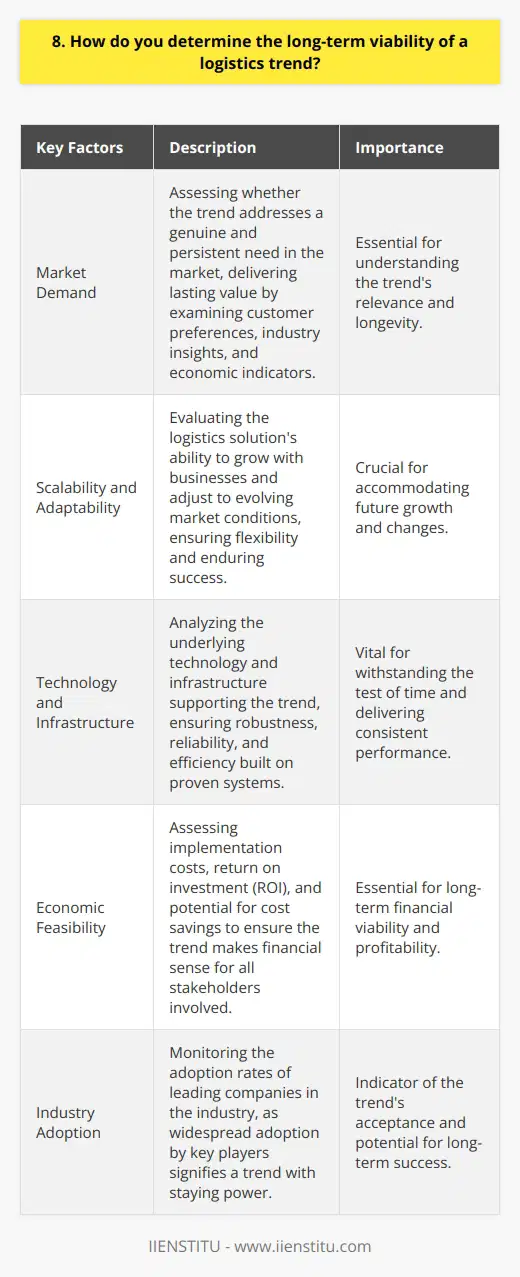
9. What are some of the most significant logistics trends you have identified in recent years?
In recent years, I've noticed several significant logistics trends that have transformed the industry. One of the most impactful developments has been the rise of e-commerce and the corresponding shift in consumer expectations.
E-commerce Boom
The explosive growth of online shopping has put immense pressure on logistics providers to adapt and innovate. Customers now expect fast, reliable, and low-cost (or even free) shipping, forcing companies to optimize their supply chains and invest in advanced technologies.
Last-Mile Delivery Innovations
To meet these demands, I've seen a surge in last-mile delivery solutions, such as same-day delivery, click-and-collect options, and even drone or robot deliveries. Logistics providers are also leveraging data analytics and AI to optimize routes and improve efficiency.
Sustainability Focus
Another significant trend is the increasing emphasis on sustainability and reducing the environmental impact of logistics operations. Many companies are investing in electric vehicles, optimizing packaging to reduce waste, and exploring ways to minimize their carbon footprint.
Circular Economy Practices
I've also observed a growing interest in circular economy practices, such as reverse logistics and product refurbishment. These initiatives not only benefit the environment but also create new revenue streams for businesses.
Resilience and Flexibility
The COVID-19 pandemic has highlighted the importance of resilience and flexibility in logistics. Companies that were able to quickly adapt their operations and maintain continuity despite disruptions have emerged as leaders in the industry.
Overall, staying attuned to these trends and proactively adapting to the changing landscape is crucial for success in the logistics sector.
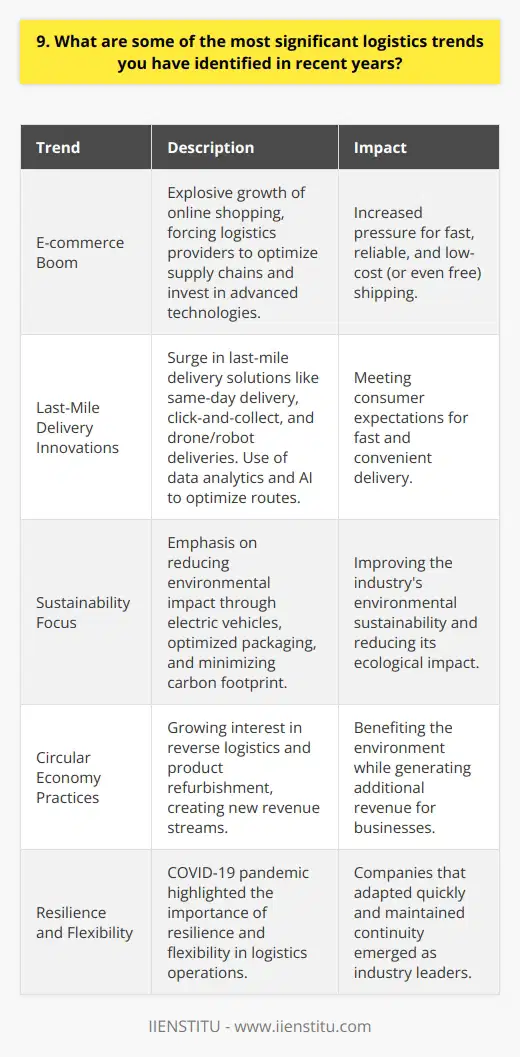
10. How do you adapt your logistics operations to accommodate emerging trends?
As a logistics professional, I stay on top of emerging trends to ensure our operations remain efficient and competitive. I regularly attend industry conferences, read trade publications, and network with colleagues to learn about the latest developments in logistics technology and best practices.
Adapting to New Technologies
When a promising new technology emerges, such as blockchain or artificial intelligence, I carefully evaluate its potential benefits for our company. If it aligns with our goals and budget, I develop a plan to pilot the technology on a small scale. This allows us to test its effectiveness and identify any challenges before implementing it more broadly.
Example: Implementing RFID Tracking
Last year, I led a project to introduce RFID tracking in our warehouses. We started with a single facility and gradually expanded to others after refining our processes. Today, RFID technology has significantly improved our inventory accuracy and order fulfillment speed.
Responding to Changing Customer Expectations
Consumer preferences continually evolve, and I strive to adapt our logistics strategies accordingly. For instance, as e-commerce has grown, customers increasingly expect faster shipping times and more flexible delivery options. To meet these demands, I have worked with our team to optimize our distribution network, partner with reliable carriers, and offer services like same-day delivery and in-store pickup.
Collaborating with Other Departments
Effectively responding to emerging trends requires close collaboration with colleagues across the organization. I regularly communicate with sales, marketing, and customer service teams to understand shifting customer needs and forecast demand. By working together, we can develop integrated solutions that drive business growth and enhance the customer experience.

11. What challenges have you faced when trying to implement changes based on logistics trends?
As a logistics professional, I've encountered several challenges when implementing changes based on emerging trends. One significant hurdle has been gaining buy-in from stakeholders who are resistant to change.
Overcoming Resistance to Change
I remember a specific instance where I proposed a new inventory management system that would streamline our processes. However, some team members were hesitant to adopt the new technology. They were comfortable with the existing methods and feared the learning curve.
To address this challenge, I focused on clear communication and education. I organized training sessions to demonstrate the benefits of the new system and how it would make their jobs easier in the long run. By involving them in the process and addressing their concerns, I gradually gained their support.
Managing Budget Constraints
Another challenge I've faced is implementing logistics changes within tight budget constraints. Balancing the need for innovation with limited financial resources can be a delicate task.
In one case, I wanted to introduce a new transportation management system to optimize our routes and reduce costs. However, the initial investment was substantial. To overcome this, I presented a detailed cost-benefit analysis to management, highlighting the long-term savings and efficiency gains. By demonstrating the ROI, I was able to secure the necessary funding.
Adapting to Evolving Customer Demands
Logistics trends are often driven by changing customer expectations. Keeping up with these demands while maintaining operational efficiency can be challenging.
I recall an instance where a key client requested faster delivery times and real-time tracking. To meet their needs, I collaborated with our IT department to develop a customized tracking system. It required significant coordination and resource allocation, but by staying agile and innovative, we successfully implemented the solution and strengthened our client relationship.
Overall, implementing changes based on logistics trends requires a proactive approach, effective communication, and a willingness to adapt. By embracing these challenges as opportunities for growth and improvement, I've been able to drive positive change within my organization.

12. How do you communicate the importance of logistics trends to stakeholders within your organization?
As a logistics professional, I understand the importance of staying up-to-date with the latest industry trends. When communicating these trends to stakeholders, I focus on how they can improve our operations and bottom line.
Tailoring the Message
I tailor my message to each stakeholder's specific role and priorities. For example, when talking to our CFO, I emphasize how adopting new technologies can reduce costs and increase efficiency. With our CEO, I focus on how staying ahead of the curve can give us a competitive edge.
Real-World Examples
To make the trends more tangible, I provide real-world examples of how other companies have successfully implemented them. Last year, I attended a conference where a major retailer shared how they used AI to optimize their supply chain. I brought back insights from their case study and shared them with our team.
Collaborating with Colleagues
I also believe in collaborating with colleagues from other departments. By working together, we can identify opportunities to leverage logistics trends across the organization. Recently, I partnered with our sales team to explore how we could use predictive analytics to better forecast demand.
Continuous Learning
Finally, I'm always looking for ways to expand my own knowledge of logistics trends. I regularly attend industry events, read trade publications, and participate in online forums. By staying informed, I can bring fresh ideas and perspectives to my conversations with stakeholders.
At the end of the day, communicating the importance of logistics trends is about showing how they can drive our business forward. By tailoring my message, providing real-world examples, collaborating with colleagues, and continuously learning, I can effectively engage stakeholders and help our organization thrive.
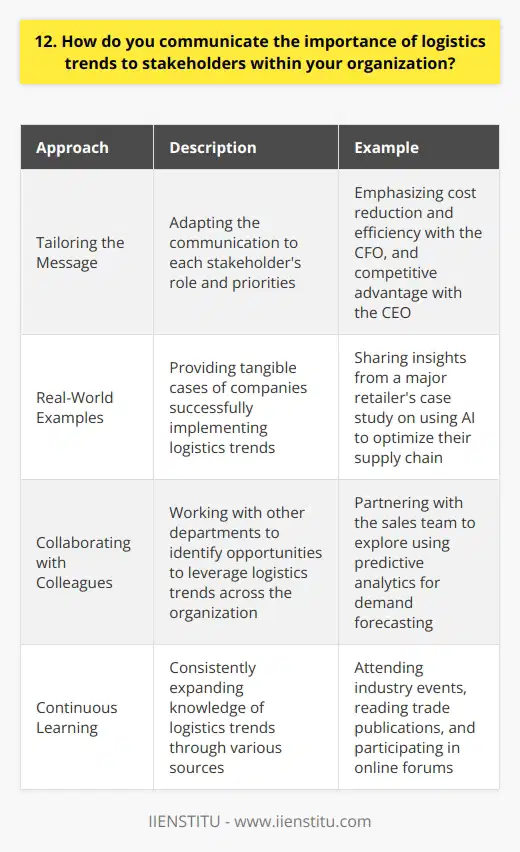
13. What metrics do you use to measure the success of your efforts to track and respond to logistics trends?
As a logistics professional, I employ several key metrics to gauge the effectiveness of my efforts in tracking and responding to industry trends:
Staying Up-to-Date with Industry News and Developments
I make it a point to read trade publications, attend conferences, and network with colleagues regularly. This helps me stay informed about the latest trends, technologies, and best practices in logistics. By staying current, I can quickly identify potential opportunities or challenges for my organization and develop strategies to address them.
Monitoring Key Performance Indicators (KPIs)
I closely monitor KPIs such as on-time delivery rates, inventory turnover, and transportation costs. These metrics provide valuable insights into our logistics operations' efficiency and effectiveness. By tracking these KPIs over time, I can identify areas for improvement and adjust our strategies accordingly.
Gathering Feedback from Stakeholders
I actively seek feedback from internal and external stakeholders, including customers, suppliers, and team members. Their input helps me understand how well we're meeting their needs and expectations. I use this feedback to refine our processes and ensure that we're always delivering value.
Conducting Regular Assessments and Audits
I schedule periodic assessments and audits of our logistics operations to identify potential gaps or inefficiencies. These reviews help me ensure that we're adhering to industry best practices and regulatory requirements. They also provide opportunities to streamline our processes and reduce costs.
By employing these metrics and strategies, I can effectively track and respond to logistics trends, ensuring that our organization remains competitive and successful in a dynamic industry landscape.
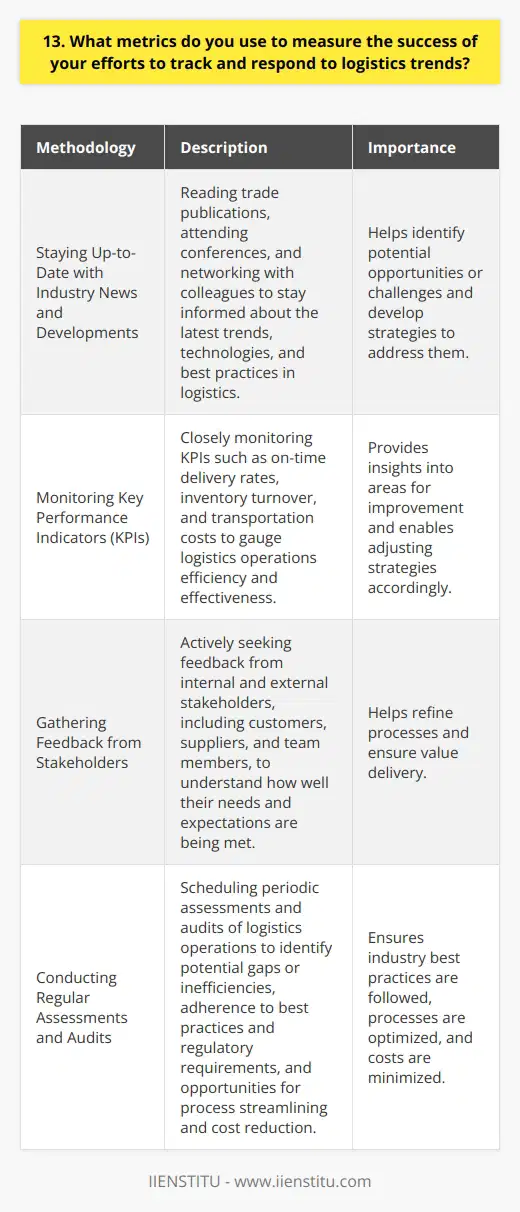
14. How do you balance the need to stay current with logistics trends and maintaining efficient day-to-day operations?
Staying current with logistics trends is crucial for driving innovation and maintaining a competitive edge. I make it a priority to regularly read industry publications, attend conferences, and network with peers to stay informed about the latest developments in logistics technology and best practices.
Balancing Innovation and Efficiency
However, I also understand the importance of maintaining efficient day-to-day operations. It's all about finding the right balance. I set aside dedicated time each week to research and explore new ideas, while ensuring that the majority of my focus remains on optimizing our current processes and delivering exceptional service to our customers.
Continuous Improvement Mindset
One strategy I've found effective is adopting a continuous improvement mindset. I encourage my team to constantly look for opportunities to streamline workflows, eliminate waste, and leverage technology to work smarter, not harder. By empowering them to take ownership of their areas of responsibility and suggest improvements, we can incrementally enhance our operations without compromising efficiency.
Piloting New Ideas
When it comes to implementing new trends or technologies, I believe in a measured approach. Rather than overhauling our entire system at once, we pilot new ideas on a smaller scale, carefully monitoring their impact on productivity and customer satisfaction. This allows us to refine our implementation strategy and ensure a smooth transition before rolling out changes more broadly.
Ultimately, staying current with logistics trends and maintaining efficient operations requires a proactive, yet pragmatic approach. By striking the right balance between innovation and execution, we can position ourselves for long-term success in this dynamic industry.
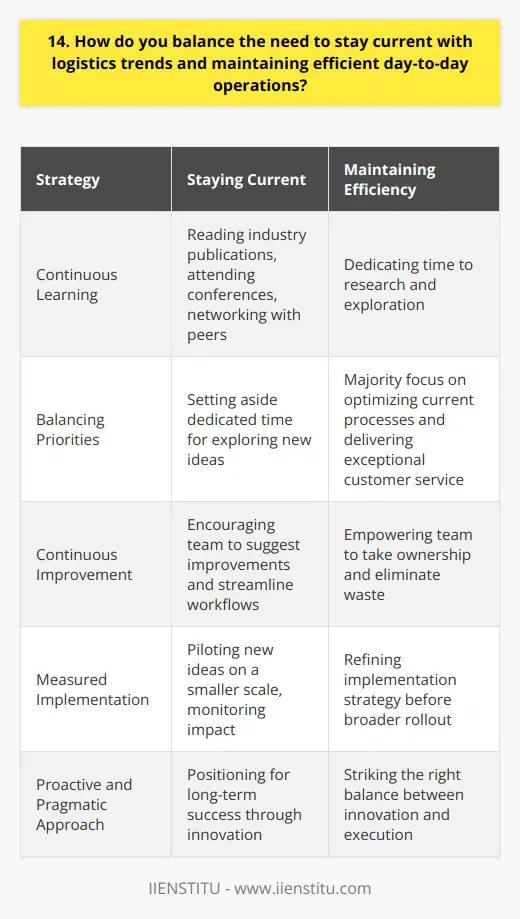
15. What role does collaboration with industry partners play in your process of tracking logistics trends?
Collaborating with industry partners is a crucial aspect of my process for staying on top of logistics trends. By fostering strong relationships with key players in the industry, I gain valuable insights and knowledge that help me navigate the ever-changing landscape of logistics.
Staying Connected
I make it a priority to attend industry conferences, seminars, and networking events. These gatherings provide excellent opportunities to connect with industry partners, share ideas, and learn about the latest trends and best practices in logistics.
Engaging in Meaningful Discussions
When I meet with industry partners, I actively engage in meaningful discussions about the challenges and opportunities facing the logistics industry. By listening to their perspectives and sharing my own thoughts and experiences, I gain a deeper understanding of the issues at hand and can develop more effective solutions.
Collaborating on Projects
Whenever possible, I seek out opportunities to collaborate with industry partners on specific projects or initiatives. By working together towards a common goal, we can pool our resources and expertise to achieve better results than we could on our own.
Learning from Each Other
Through these collaborations, I not only contribute my own knowledge and skills but also learn valuable lessons from my industry partners. Their unique perspectives and experiences help me see things in a new light and consider approaches I may not have thought of before.
Staying Ahead of the Curve
By maintaining strong partnerships with industry leaders, I can stay ahead of the curve when it comes to logistics trends. Through regular communication and collaboration, I can anticipate changes in the industry and adapt my strategies accordingly to ensure continued success.
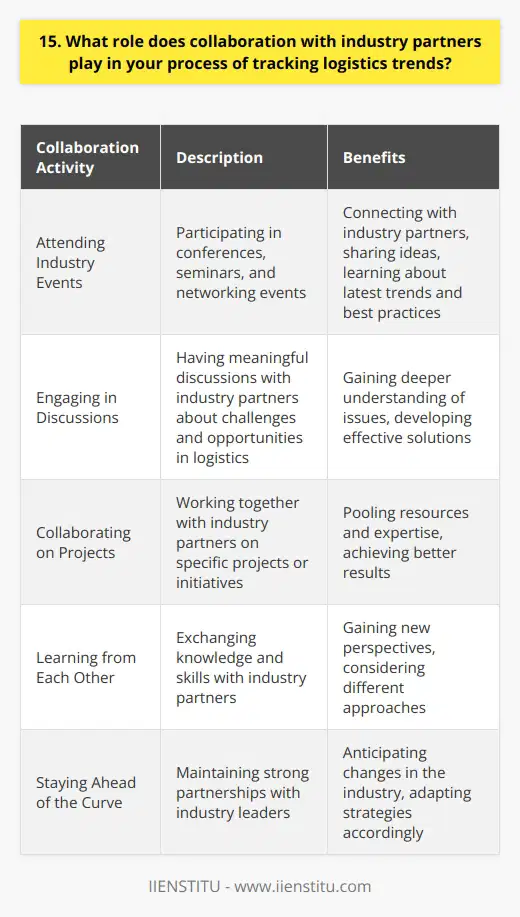
16. How do you ensure that your team is well-informed about the latest logistics trends?
As a logistics manager, I understand the importance of keeping my team informed about the latest industry trends. Here are some strategies I employ to ensure everyone stays up-to-date:
Regular Team Meetings
I hold weekly meetings where we discuss any new developments or changes in the logistics landscape. These meetings provide an opportunity for team members to share their insights and experiences.
Encouraging Professional Development
I encourage my team to attend conferences, workshops, and training sessions to expand their knowledge. When someone attends an event, they share what they learned with the rest of the team.
Sharing Industry News and Articles
Whenever I come across an interesting article or news story related to logistics, I share it with my team. I also encourage them to do the same if they find something relevant.
Collaborating with Other Departments
We regularly collaborate with other departments, such as sales and marketing, to gain a broader perspective on industry trends. This helps us stay informed about how logistics impacts other areas of the business.
Analyzing Data and Metrics
I believe in the power of data to reveal trends and opportunities. We regularly analyze our performance metrics and look for patterns that can help us improve our processes and stay ahead of the curve.
By implementing these strategies, I can ensure that my team is always well-informed and prepared to tackle any challenges that come our way. Staying on top of industry trends is essential for success in the fast-paced world of logistics.

17. What are some of the most promising logistics trends on the horizon, in your opinion?
In my opinion, some of the most exciting logistics trends on the horizon are:
Automation and Robotics
I believe that the increasing use of automation and robotics in warehouses and distribution centers will revolutionize logistics. From my experience, these technologies can significantly improve efficiency, accuracy, and speed in order fulfillment processes. I'm excited to see how they will continue to advance and transform the industry.
Sustainable Logistics Solutions
As someone who cares deeply about the environment, I'm thrilled to see the growing focus on sustainable logistics practices. Companies are exploring eco-friendly packaging materials, optimizing routes to reduce carbon emissions, and investing in electric delivery vehicles. These initiatives not only benefit the planet but also appeal to environmentally conscious consumers.
Real-Time Visibility and Tracking
Another promising trend is the adoption of real-time visibility and tracking technologies. I recently had a positive experience with a retailer that provided live updates on my package's location. This level of transparency enhances customer satisfaction and helps businesses optimize their supply chain operations.
Collaborative Logistics Networks
The rise of collaborative logistics networks excites me. By sharing resources, data, and expertise, companies can achieve greater efficiency and cost savings. I believe that fostering strong partnerships and embracing a collaborative mindset will be key to success in the future of logistics.
These are just a few of the promising trends I see shaping the logistics industry. As someone passionate about innovation and continuous improvement, I'm eager to contribute to and learn from these exciting developments in my career.
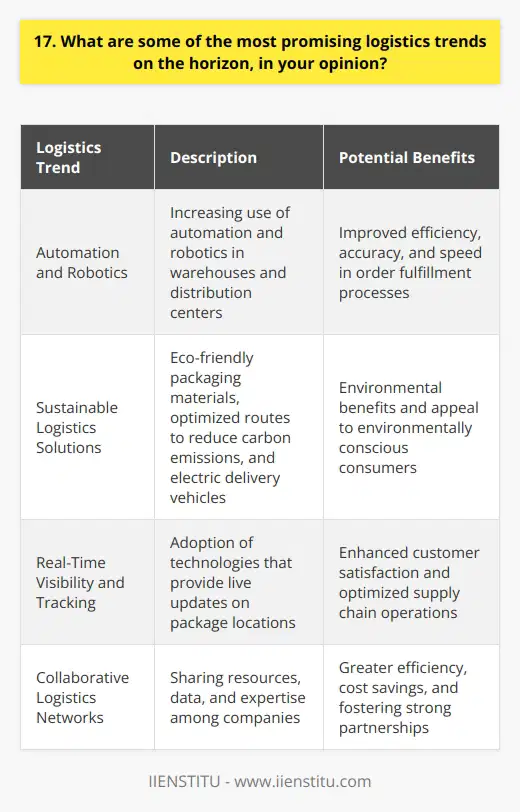
18. How do you determine when it is the right time to invest in a new logistics trend?
As a logistics professional, I believe that the right time to invest in a new logistics trend depends on several factors. Before making a decision, it's crucial to thoroughly research the trend and understand its potential benefits and drawbacks.
Assess the Trend's Alignment with Your Business Goals
I always start by evaluating how well the trend aligns with my company's strategic objectives and long-term vision. If it has the potential to significantly improve our operations, customer satisfaction, or bottom line, it's worth considering.
Conduct a Cost-Benefit Analysis
Next, I conduct a comprehensive cost-benefit analysis. This helps me determine if the investment will yield a positive return and justify the resources required for implementation.
Consider the Maturity and Stability of the Trend
I also assess the maturity and stability of the trend. I prefer to invest in proven technologies and practices that have demonstrated success in real-world applications, rather than jumping on the latest fad.
Evaluate Your Company's Readiness
Finally, I consider my company's readiness to adopt the trend. This includes evaluating our current infrastructure, workforce skills, and organizational culture. If significant changes or training are required, I factor that into my decision-making process.
Ultimately, the right time to invest in a new logistics trend is when it aligns with your business goals, offers a clear return on investment, and can be implemented successfully within your organization.

19. What strategies do you use to mitigate risks associated with adopting new logistics trends?
When adopting new logistics trends, I take a proactive approach to identify and mitigate potential risks. I start by thoroughly researching the trend, understanding its benefits and drawbacks, and assessing its compatibility with our existing processes.
Collaboration and Communication
I engage all relevant stakeholders in discussions to gather their insights and concerns. By fostering open communication, we can identify risks early and develop strategies to address them. I also reach out to industry peers who have implemented similar trends to learn from their experiences.
Pilot Projects and Incremental Implementation
Instead of rushing into full-scale adoption, I advocate for pilot projects and incremental implementation. This allows us to test the trend in a controlled environment, monitor its performance, and make necessary adjustments. By starting small, we can minimize the impact of potential risks and ensure a smoother transition.
Contingency Planning
I believe in having robust contingency plans in place. I work with my team to identify potential failure points and develop backup strategies. This ensures that we can quickly respond to any issues that may arise and maintain the continuity of our logistics operations.
Continuous Monitoring and Evaluation
Even after successful implementation, I maintain a vigilant approach. I establish key performance indicators to monitor the effectiveness of the new trend and regularly assess its impact on our logistics processes. By staying alert and adaptable, we can swiftly address any emerging risks and make necessary modifications.
Ultimately, my goal is to embrace new logistics trends that drive efficiency and competitiveness while minimizing risks. By taking a proactive, collaborative, and data-driven approach, I strive to ensure successful adoption and seamless integration into our logistics operations.
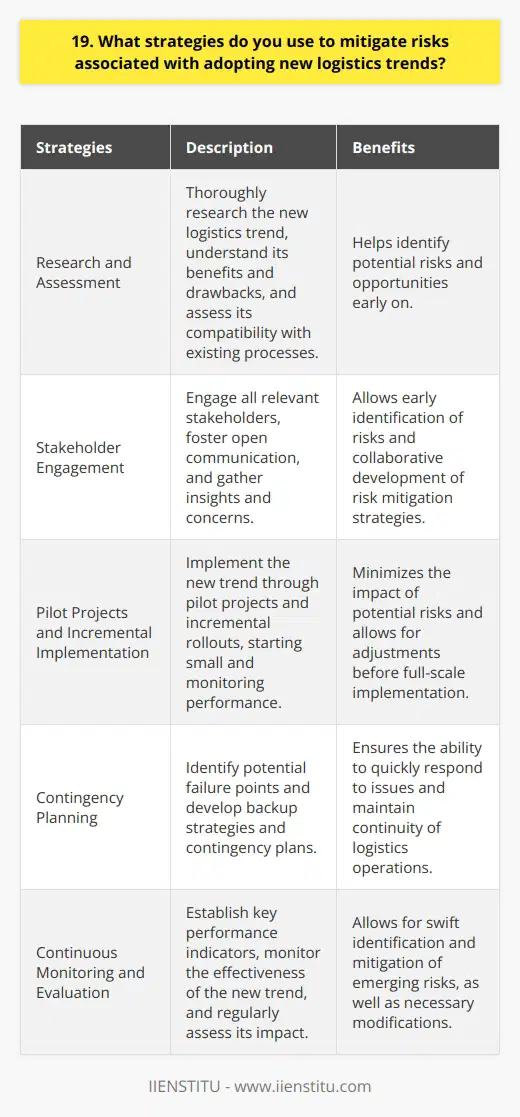
20. How do you foster a culture of innovation and adaptability within your logistics team?
I believe that fostering a culture of innovation and adaptability within a logistics team is crucial for success. Here are some key strategies I employ:
Encourage Open Communication
I create an environment where team members feel comfortable sharing ideas and concerns. Regular meetings and brainstorming sessions help facilitate this open dialogue. When people feel heard, they're more likely to think creatively and propose innovative solutions.
Embrace Calculated Risk-Taking
Innovation often involves some degree of risk. I encourage my team to take calculated risks and view failures as learning opportunities. We celebrate successes, but also analyze setbacks to identify areas for improvement. This mindset helps us stay agile and adapt quickly to changing circumstances.
Foster Continuous Learning
I believe in the power of continuous learning to drive innovation. I provide my team with opportunities for training, attending industry conferences, and cross-functional collaboration. Exposing them to new ideas and perspectives helps spark creativity and keeps us at the forefront of industry trends.
Lead by Example
As a leader, I strive to model the behaviors I want to see in my team. I openly share my own innovative ideas, admit when I'm wrong, and adapt my approach as needed. By demonstrating a growth mindset, I inspire my team to do the same.
Ultimately, fostering innovation and adaptability requires a combination of open-mindedness, calculated risk-taking, continuous learning, and leading by example. By creating a supportive environment that values these qualities, I've been able to build high-performing logistics teams that consistently deliver creative solutions.
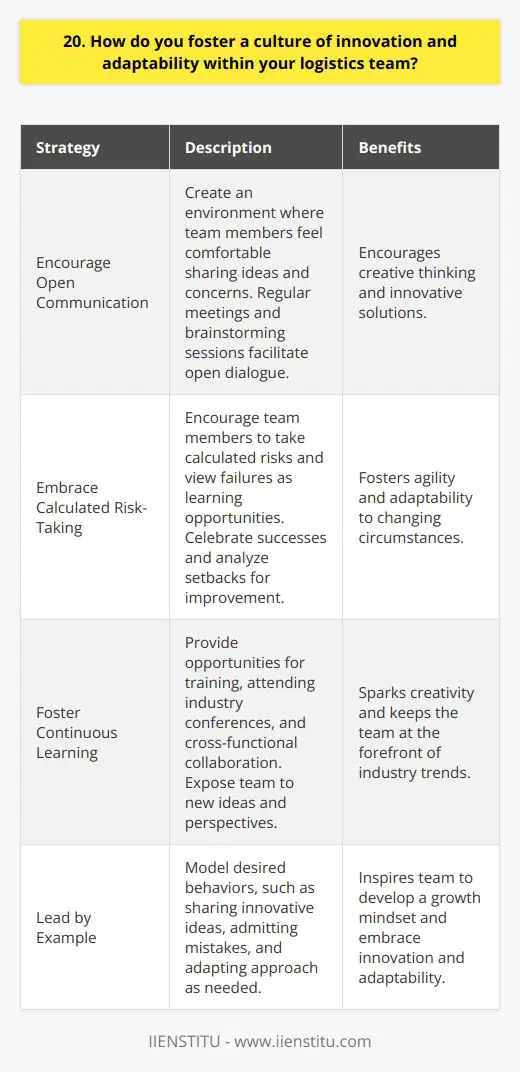
21. What are some of the most significant challenges facing the logistics industry today, and how do you stay informed about them?
The logistics industry faces significant challenges today, including rising fuel costs, supply chain disruptions, and a shortage of skilled workers. Staying informed about these challenges is crucial for logistics professionals to adapt and find innovative solutions.
Keeping Up with Industry News and Trends
I make it a priority to read industry publications, attend conferences, and network with colleagues. Last month, I attended a supply chain management seminar where I learned about the latest technologies and best practices. It was an eye-opening experience that gave me valuable insights into how companies are navigating the current challenges.
Collaborating with Stakeholders
Another way I stay informed is by regularly communicating with clients, suppliers, and other stakeholders. By understanding their pain points and concerns, I can better anticipate and address potential issues. Just last week, I had a productive meeting with a key client where we discussed ways to optimize their transportation routes and reduce costs.
Embracing Technology and Innovation
I believe that embracing technology and innovation is essential for staying ahead of the curve. I'm always on the lookout for new software, automation tools, and data analytics platforms that can help streamline operations and improve efficiency. Recently, I implemented a new warehouse management system at my current company, which has greatly improved inventory accuracy and reduced picking times.
Continuous Learning and Skill Development
Finally, I'm a strong believer in continuous learning and skill development. I regularly attend training sessions and workshops to enhance my knowledge and stay up-to-date with the latest industry trends. Last year, I earned my APICS certification in supply chain management, which has been invaluable in my current role.
In summary, staying informed about the challenges facing the logistics industry requires a proactive approach. By combining industry knowledge, collaboration with stakeholders, technology adoption, and continuous learning, I believe I can effectively navigate these challenges and drive success for the company.
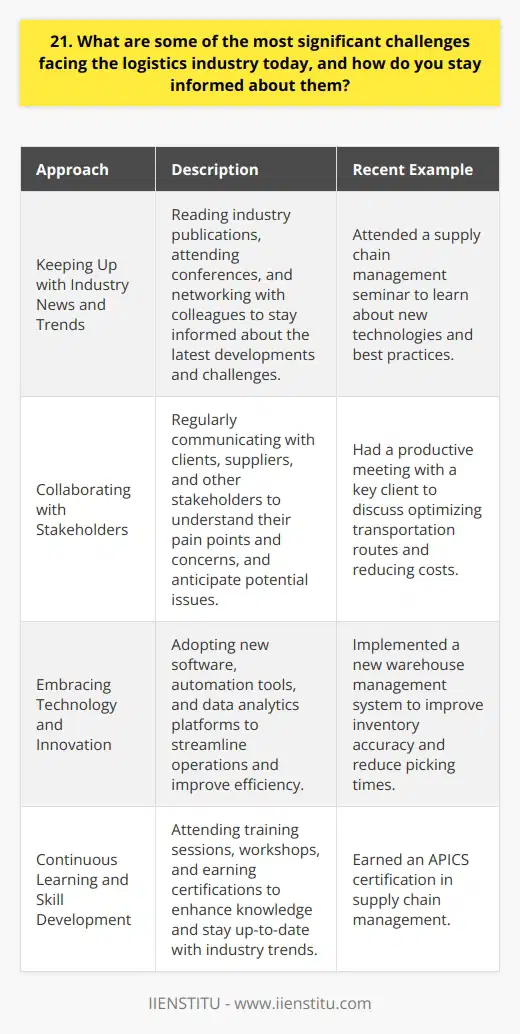
22. How do you assess the potential ROI of investing in a new logistics trend?
When assessing the potential ROI of investing in a new logistics trend, I consider several key factors. First, I evaluate the scalability and long-term viability of the trend. Will it deliver sustainable benefits, or is it just a passing fad?
Analyzing Cost Savings and Efficiency Gains
Next, I dive into the numbers. I analyze the projected cost savings and efficiency gains the trend promises to deliver. Are these benefits significant enough to justify the investment? I also consider the implementation costs and timeline.
Evaluating Competitive Advantage
Another crucial aspect is the competitive advantage the trend could provide. Will it help us differentiate ourselves in the market? Could it attract new customers or improve satisfaction among existing ones? I think about how the trend aligns with our overall business strategy.
Assessing Risks and Challenges
Of course, I also assess the potential risks and challenges. What are the obstacles we might face during implementation? Are there any legal, regulatory, or technological hurdles to overcome? I weigh these risks against the potential benefits.
Drawing from Personal Experience
In my previous role, I led the evaluation and implementation of a new warehouse automation system. It was a significant investment, but our thorough ROI analysis showed it would pay off in the long run. We considered factors like labor cost savings, improved inventory accuracy, and faster order processing times.
The project wasn't without challenges, but our team's diligence in assessing the ROI helped us make the right decision. The automation system ended up being a game-changer for our operations.
Continuous Evaluation
Finally, I believe in continuous evaluation. Even after implementing a new trend, it's important to track performance and reassess the ROI regularly. Markets, technologies, and customer needs can change, so staying agile is key.
In summary, assessing the ROI of a new logistics trend requires a holistic approach. It's about looking at the big picture - the financial benefits, strategic advantages, and potential risks. By carefully weighing these factors, we can make informed decisions that drive long-term success.
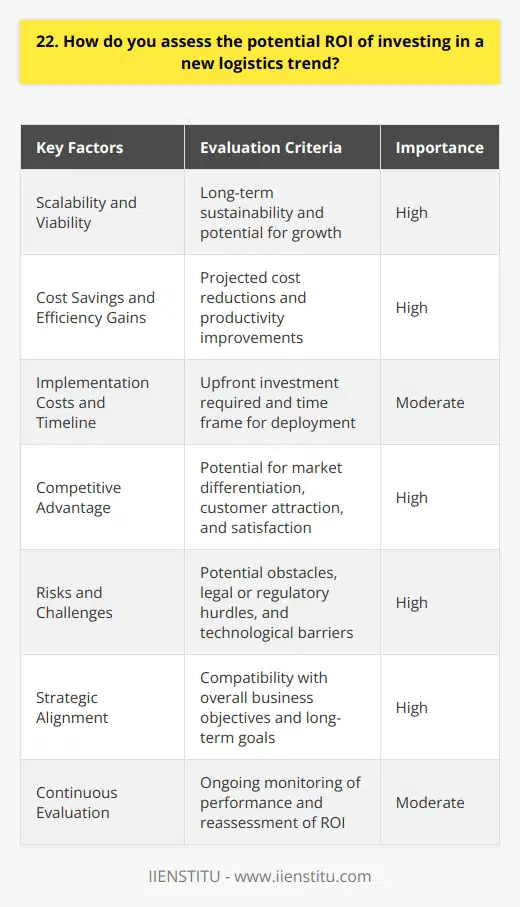
23. What role does data analytics play in your process of tracking logistics trends?
Data analytics plays a crucial role in my process of tracking logistics trends. By analyzing historical data, I can identify patterns and forecast future demand, allowing me to optimize inventory levels and reduce costs.
Identifying Key Performance Indicators
I start by identifying the key performance indicators (KPIs) that are most relevant to our logistics operations. These might include on-time delivery rates, inventory turnover, and transportation costs. By focusing on these metrics, I can quickly spot areas for improvement.
Collecting and Cleaning Data
Next, I collect data from various sources, such as our warehouse management system and transportation providers. It's important to ensure the data is clean and accurate before beginning any analysis. I often use Excel or SQL to manipulate and clean the data.
Analyzing Trends and Patterns
Once the data is ready, I use various analytical techniques to identify trends and patterns. For example, I might use regression analysis to determine the relationship between order volume and delivery times. Or I might use time series analysis to forecast future demand based on historical sales data.
One time, I noticed that our on-time delivery rates were consistently lower for orders shipped to a particular region. By digging deeper into the data, I discovered that our transportation provider for that region was experiencing frequent delays. Armed with this insight, we were able to switch to a more reliable provider and improve our delivery performance.
Communicating Insights and Recommendations
Finally, I communicate my findings and recommendations to stakeholders across the organization. I believe in using clear, concise language and visualizations to make complex data easy to understand. By collaborating with colleagues in operations, sales, and finance, we can turn data-driven insights into actionable strategies that drive business results.
In my experience, data analytics is a powerful tool for tracking logistics trends and identifying opportunities for improvement. By leveraging data to make informed decisions, we can optimize our supply chain, reduce costs, and ultimately deliver better service to our customers.

24. How do you stay informed about logistics trends in different regions or countries?
As a logistics professional, I make it a priority to stay up-to-date on the latest trends and developments in different regions and countries. One of the key ways I do this is by actively participating in industry conferences and events, both locally and internationally. These gatherings provide invaluable opportunities to network with peers, learn from industry leaders, and gain insights into the unique challenges and opportunities facing logistics in various parts of the world.
Leveraging Industry Publications and Online Resources
I also make a point of regularly reading industry publications and blogs, such as Supply Chain Digest, Logistics Management, and Transport Topics. These sources offer a wealth of information on emerging trends, best practices, and case studies from around the globe. Additionally, I leverage online resources like webinars, podcasts, and social media groups to tap into the collective knowledge and experiences of logistics professionals worldwide.
Engaging with Colleagues and Partners
Another important aspect of staying informed is engaging with colleagues and partners who have direct experience working in different regions. I make an effort to collaborate with team members who have worked on international projects, as they can provide valuable first-hand perspectives on the unique logistics landscapes in those areas. Building strong relationships with global partners and suppliers is also crucial, as they can offer insights into local market conditions, regulatory requirements, and cultural considerations.
Continuous Learning and Skill Development
Finally, I believe that continuous learning and skill development are essential for staying at the forefront of logistics trends. I regularly pursue online courses and certifications to expand my knowledge of global logistics practices, supply chain management, and international trade regulations. By investing in my own professional growth, I can better understand and adapt to the ever-evolving logistics landscape across different regions and countries.

25. What are some of the most important skills for logistics professionals to develop in order to stay current with industry trends?
As a logistics professional, I believe staying current with industry trends is crucial for success. In my experience, developing strong analytical skills has been invaluable. I constantly analyze data to identify patterns and opportunities for improvement.
Effective Communication
Clear communication is essential in logistics. I make it a priority to listen actively and express myself concisely. Collaborating with colleagues and clients helps ensure smooth operations.
Adaptability and Flexibility
The logistics industry is constantly evolving. I've learned to embrace change and adapt quickly to new technologies and processes. Being flexible allows me to find creative solutions to challenges.
Continuous Learning
I'm passionate about continuous learning. I regularly attend industry conferences and workshops to expand my knowledge. Staying informed about the latest trends and best practices helps me stay ahead of the curve.
Technology Proficiency
Technology plays a vital role in modern logistics. I invest time in mastering relevant software and systems. Proficiency in technology enables me to streamline processes and improve efficiency.
In summary, developing analytical skills, communicating effectively, adapting to change, embracing continuous learning, and leveraging technology are key to staying current in the dynamic logistics industry.

26. How do you prioritize logistics trends based on their potential impact on customer satisfaction?
When prioritizing logistics trends, I focus on how each trend directly impacts the customer experience. I ask myself, "Will this trend make the customer's life easier or more difficult?"
Analyzing Trends for Customer Impact
I carefully analyze each trend to determine its potential effect on customer satisfaction. For example, last year a new trend emerged in our industry that promised to cut costs but would have made deliveries less reliable. I advised against adopting it because I knew it would frustrate our customers.
Balancing Innovation with Reliability
While it's important to stay on the cutting edge, I believe we must balance innovation with dependability. Customers appreciate cool new features, but not at the expense of the core service they expect. I always prioritize trends that enhance our offerings without compromising quality.
Seeking Customer Feedback
Ultimately, the customer's voice matters most. I regularly seek feedback through surveys, reviews, and conversations. This input directly shapes how I rank logistics trends. If customers are excited about a new development, I bump it up on my priority list.
In my experience, putting the customer first is always the right call. By carefully evaluating logistics trends through the lens of customer satisfaction, we can adapt to a changing market while keeping our clientele happy. It's a win-win approach that has served me well in my career.
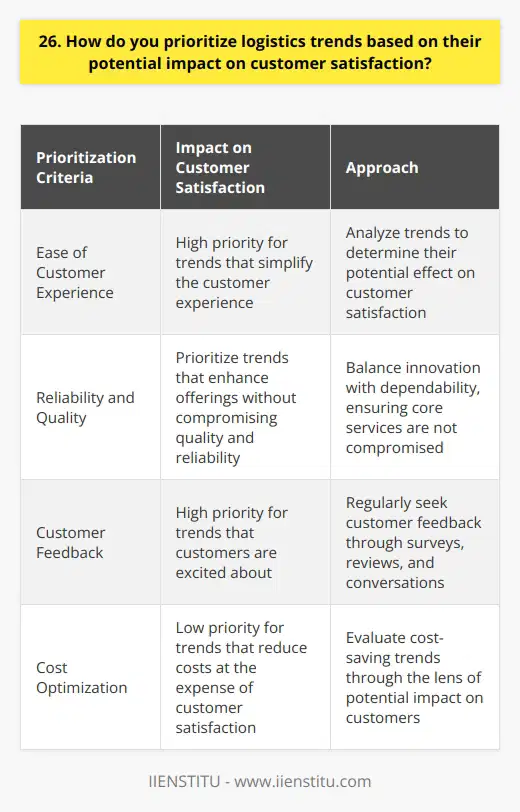
27. What strategies do you use to ensure that your logistics operations remain flexible and adaptable to changing trends?
As a logistics professional, I understand the importance of adaptability in an ever-changing industry. Over the years, I've developed several strategies to ensure my operations remain flexible.
Continuous Monitoring and Analysis
I closely monitor market trends, customer demands, and technological advancements. By staying informed, I can anticipate potential changes and proactively adjust my strategies. I regularly analyze data from various sources to identify patterns and opportunities for improvement.
Collaboration with Stakeholders
I believe in fostering strong relationships with suppliers, partners, and customers. Through open communication and collaboration, we can quickly respond to changing requirements. I encourage feedback and ideas from all stakeholders to ensure our operations align with their needs.
Flexible Infrastructure and Processes
I've implemented a modular and scalable infrastructure that allows for easy adaptation. Our processes are designed to be flexible, enabling us to quickly modify routes, adjust inventory levels, and reallocate resources when needed. This agility has proven invaluable in navigating unexpected challenges.
Embracing Technology
I'm a firm believer in leveraging technology to enhance flexibility. I stay updated on the latest logistics software, automation tools, and data analytics platforms. By integrating these technologies into our operations, we can optimize routes, streamline processes, and make data-driven decisions in real-time.
Continuous Improvement and Learning
I foster a culture of continuous improvement within my team. We regularly review our performance, identify areas for optimization, and implement necessary changes. I encourage my team members to expand their skills and knowledge through training and development programs. This ensures we have the expertise to adapt to new challenges.
By combining these strategies, I've successfully navigated numerous changes in the logistics landscape. I'm confident in my ability to lead flexible and adaptable operations that deliver results in any circumstance.
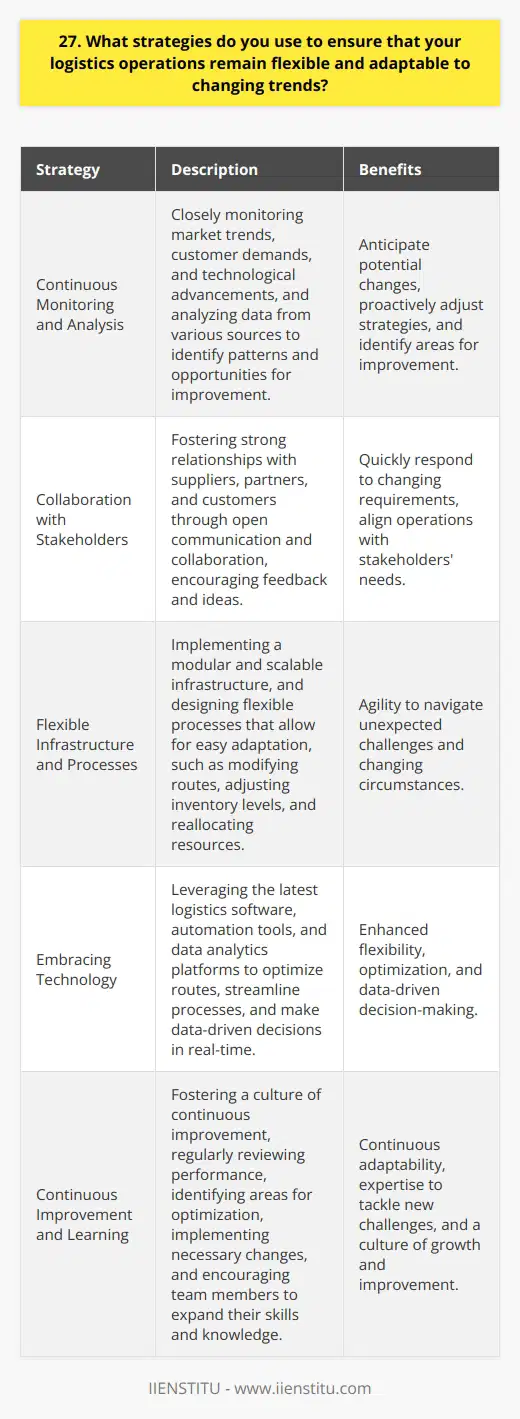
28. How do you assess the environmental impact of logistics trends, and how does this factor into your decision-making process?
As a logistics professional, I understand the importance of considering the environmental impact of industry trends. It's a complex issue that requires careful analysis and strategic decision-making.
Assessing Environmental Impact
When evaluating logistics trends, I look at factors like carbon emissions, energy consumption, and waste generation. I ask myself, "How will this trend affect the environment in the short and long term?" It's not always easy to quantify, but it's a crucial part of the assessment process.
Real-World Example
In my previous role, we were considering a new packaging material that was lighter and cheaper than our current option. However, after conducting an environmental impact analysis, we discovered that the production process for this material was significantly more harmful to the environment. We ultimately decided to stick with our current packaging, even though it was more expensive, because it aligned with our company's sustainability goals.
Balancing Business and Environmental Needs
Of course, as a business, we can't always prioritize the environment over other factors like cost and efficiency. It's about finding a balance and making strategic decisions that benefit both the company and the planet.
Collaboration is Key
I believe that collaboration is essential when it comes to making environmentally conscious decisions in logistics. We need to work closely with suppliers, customers, and even competitors to find innovative solutions that reduce our collective environmental impact.
At the end of the day, assessing the environmental impact of logistics trends is a complex but necessary part of my decision-making process. By carefully weighing the costs and benefits, and collaborating with others in the industry, I believe we can find ways to optimize our supply chains while also protecting the planet we all share.
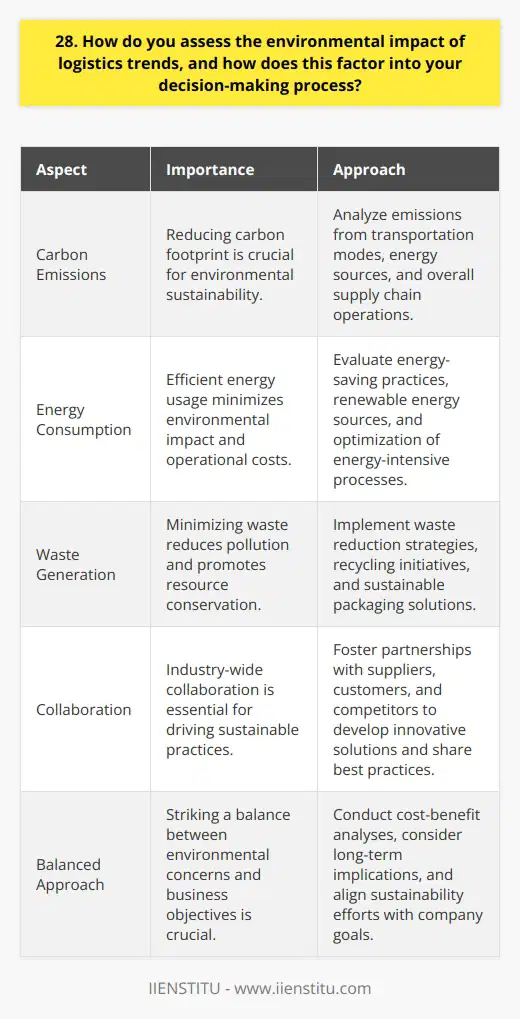
29. What are some of the most innovative logistics trends you have come across, and how have they influenced your work?
As a logistics professional, I've encountered several innovative trends that have greatly influenced my work. One such trend is the use of autonomous vehicles and drones for last-mile delivery. This has significantly reduced delivery times and costs while increasing efficiency. Another trend is the integration of artificial intelligence and machine learning in supply chain management. These technologies have enabled real-time tracking, predictive analytics, and optimized decision-making.
Blockchain Technology
I've also been fascinated by the potential of blockchain technology in logistics. It offers enhanced transparency, traceability, and security across the supply chain. In my experience, blockchain has helped streamline processes, reduce paperwork, and improve collaboration among stakeholders. It's a game-changer in terms of building trust and efficiency in logistics operations.
Internet of Things (IoT)
The Internet of Things (IoT) is another trend that has caught my attention. IoT devices and sensors enable real-time monitoring of assets, inventory, and shipments. This has allowed me to optimize routes, reduce waste, and enhance customer service. By leveraging IoT data, I've been able to make data-driven decisions and improve overall logistics performance.
Sustainability and Green Logistics
Sustainability and green logistics have also become increasingly important in my work. I've been exploring eco-friendly packaging solutions, optimizing transportation to reduce carbon emissions, and implementing reverse logistics for product recycling. These initiatives not only contribute to environmental sustainability but also help reduce costs and improve brand reputation.
Overall, staying up-to-date with these innovative logistics trends has been crucial in my professional growth. They have enabled me to optimize operations, enhance customer satisfaction, and drive continuous improvement in the supply chain.

30. How do you continuously improve your process of tracking and responding to logistics trends over time?
As a logistics professional, I'm always looking for ways to improve my process of tracking and responding to trends. Over the years, I've developed a few key strategies that have helped me stay on top of the latest developments in the industry.
Staying Informed
One of the most important things I do is to stay informed about what's happening in logistics. I regularly read industry publications, attend conferences and webinars, and network with other professionals. This helps me identify emerging trends early on and think about how they might impact my work.
Analyzing Data
Another critical aspect of my process is analyzing data. I look at metrics like shipping volumes, delivery times, and customer feedback to spot patterns and identify areas for improvement. By regularly reviewing this information, I can make data-driven decisions and adjust my strategies as needed.
Collaborating with Stakeholders
I also believe in the importance of collaborating with stakeholders across the supply chain. By working closely with suppliers, carriers, and customers, I can get a more holistic view of the logistics landscape and identify opportunities for optimization. Regular communication and idea-sharing help me stay agile and responsive to changing needs.
Embracing Technology
Finally, I'm always looking for ways to leverage technology to improve my process. Whether it's using software to automate tasks, implementing real-time tracking systems, or exploring emerging technologies like blockchain, I believe that innovation is key to staying ahead of the curve in logistics.
By combining these strategies – staying informed, analyzing data, collaborating with stakeholders, and embracing technology – I'm able to continuously improve my process of tracking and responding to logistics trends over time. It's an ongoing effort, but one that I believe is essential for success in this dynamic industry.
